Pollinator Plants for Wild Yards
Pollinators need our help. Planting your yard with flowering plants that attract birds, butterflies and bees can help. Often, we think that all pollinators are attracted to all flowers, but many species have evolved to prefer certain plants. The annuals and perennials listed below are some popular varieties that are easy to grow and attractive to many species.
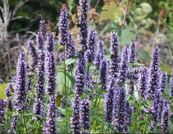 Anise hyssop (Agastache foeniculum)
Anise hyssop (Agastache foeniculum)
Anise hyssop (Agastache foeniculum) Anise hyssop is a member of the mint family. These plants contain the chemical methyl eugenol in their pollen and nectar that supports bees because it is nutritious and has antibacterial/antifungal properties. One spike on an anise hyssop plant can have up to 90,000 flowers, making it very attractive to insect pollinators as well as hummingbirds. It is easy to grow from seed sown directly in the ground in spring. It thrives in full sun and well-drained soil and can tolerate some drought. It is a vigorous grower, transplants easily, and can be transplanted and can be moved elsewhere in your garden or shared.
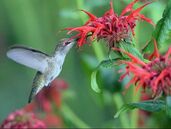 Bee balm (Monarda sp.)
Bee balm (Monarda sp.)
Bee balm (Monarda sp.) With its tousled red head, bee balm is highly attractive to swallowtail butterflies and hummingbirds. This early summer bloomer is an easy-to-grow perennial. Has a minty fragrance that repels deer. Plant in full sun. Prefers moist, well-drained soil.
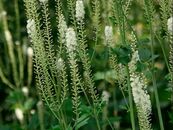 Black Cohosh (Actaea racemosa)
Black Cohosh (Actaea racemosa)
Black Cohosh (Actaea racemosa) Also called Bugbane or Snakeroot. This regal member of the buttercup family features pure white flowers in long, dramatic spikes on stems 2-3 feet tall. Grows well in sun or shade. Provide water liberally. The compound leaves emerge in early spring and remain attractive through frost. Blooms in summer and fall. Excellent butterfly nectar plant.
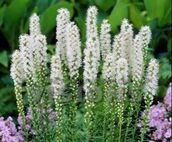 Blazing Star (Liatris spp.)
Blazing Star (Liatris spp.)
Blazing Star (Liatris spp.) Also called Gayfeather, this native North American wildflower features a dramatic, dense pink or white spike of long lasting flower heads. Good cut flower fresh or dry. Prefers fertile, sandy soil and full sun. Butterfly nectar plant.
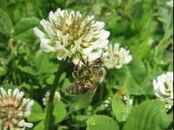 Clover (Trifolium spp.)
Clover (Trifolium spp.)
Clover (Trifolium spp.) Great pollinator plant. For the greatest pollinator benefit, plant a variety of species: all are high-value bee plants. Attracts a wide variety of bees, butterflies, and wasps. Clovers are mostly intolerant of acidic soils or drought, and dry weather can reduce nectar flow. Host plant for caterpillars of gray hairstreak (Strymon melinus), eastern tailed-blue (Cupido comyntas), orange sulphur (Colias eurytheme), clouded sulphur (C. philodice).
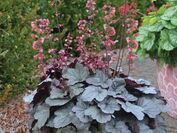 Coralbells (Heuchera sanguinea)
Coralbells (Heuchera sanguinea)
Coralbells (Heuchera sanguinea) A lovely species in flower with small, delicate red flowers over abundant foliage that attract hummingbirds. Plant in part shade.
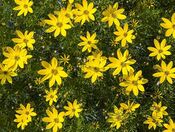 Coreopsis (Coreopsis verticillata)
Coreopsis (Coreopsis verticillata)
Coreopsis (Coreopsis verticillata) An indispensable wildflower for the sunny garden. Easy, undemanding plant that is highly attractive to butterflies. The pale yellow flowers of Coreopsis provide a cheerful accent for the front of the garden. Grows to a height of approximately 1-2 feet. Grows well in sun to part-sun.
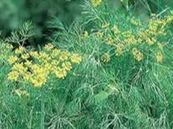 Dill (Anethum graveolens)
Dill (Anethum graveolens)
Dill (Anethum graveolensA) Dill is in the same family as parsley and celery. This annual is an excellent larval food source for black swallowtail butterflies. Plant in full sun and leave a little extra in your kitchen garden for pollinators.
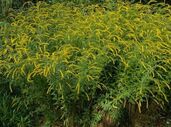 Goldenrod (Solidago spp.)
Goldenrod (Solidago spp.)
Goldenrod (Solidago spp.) This is one of the most important plant groups for native bees. There is a myth that goldenrods cause allergies, but their pollen is heavy and sticky and does not float. Goldenrods have been in the British nursery trade for years and are among the most important late-season pollinator plants. Honey bees frequently collect large amounts of goldenrod nectar prior to winter; other bees use the pollen to provision late-season nests.
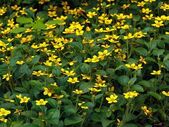 Green & Gold (Chrysogonum virginianum)
Green & Gold (Chrysogonum virginianum)
Green & Gold (Chrysogonum virginianum) This eastern American wildflower makes a wonderful, low ground cover with yellow, daisy-like flowers in the spring. A great plant for the woodland garden or shady area.
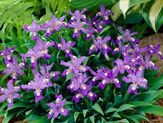 Dwarf Crested Iris (Iris cristata)
Dwarf Crested Iris (Iris cristata)
Dwarf Crested Iris (Iris cristata) An easy and beautiful wildflower for the shady or woodland garden, dwarf crested iris has pale violet flowers and only grows to 4 inches. A good spring wildflower. Plant in part sun. Native to the eastern U.S.
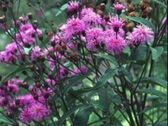 Ironweed (Vernonnia gigantea)
Ironweed (Vernonnia gigantea)
Ironweed (Vernonnia gigantea) This tall perennial features many red-violet, flat-topped flower heads on top of tall, strong stalks and blooms from late summer to fall. A member of the aster family, it is a sizable plant for the back of garden beds and rain gardens and has dark green, lance-shaped leaves. Many bees, butterflies, and skippers use the nectar and pollen.
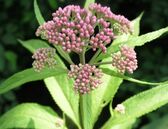
Joe Pye Weed (Eutrochium maculatum) This perennial is statuesque in appearance, especially when in bloom. Its pink to purplish blossoms appear in flattened terminal clusters and last a long time, from late summer into the fall. Their nectar is important to many butterfly species. Easy to grow in full or part sun. Typically grows to a height of 4 to 7 feet tall.
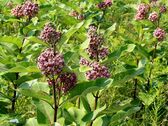 Milkweed, Common (Asclepias syriaca)
Milkweed, Common (Asclepias syriaca)
Milkweed, Common (Asclepias syriaca) Monarchs co-evolved with milkweeds and developed a unique adaptation that allows their caterpillars to feed on a plant that many other insects cannot tolerate. The latex-based sap produced by milkweed plants contains toxic compounds called cardiac glycosides. Most other insects cannot digest these toxins; it kills them or they avoid it all together. Monarch caterpillars, however, absorb the toxins as they feed on milkweed leaves, making the caterpillars themselves toxic to potential predators. The toxins found in this monarch butterfly host plant help protect the caterpillars and adult butterflies from birds and other predators. Plant in full sun. Grows 4-6 feet tall.
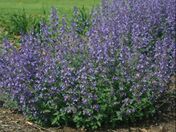 Nepeta (Nepeta spp.)
Nepeta (Nepeta spp.)
Nepeta (Nepeta spp.) Also called Catmint, Nepeta is used as a food plant by the larvae of both butterfly and moth species and as nectar sources by insect pollinators such as honeybees, as well as hummingbirds. While it attracts these beneficial pollinators, it can also help deter other pests in your garden like aphids and squashbugs. Nepeta is best grown in average, dry to medium moisture, well-drained soil in full sun to part shade. It thrives well in dry soils in full sun and is very drought tolerant.
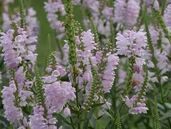 Obedient Plant (Physostegia virginiana)
Obedient Plant (Physostegia virginiana)
Obedient Plant, False Dragonhead (Physostegia virginiana) A native plant of the eastern US, obedient plant gets its name from the way the upright spike of tubular flowers follows the path of the sun. Does well in part-sun or full sun. A nectar plant for hummingbirds and butterflies.
See more annual and perennial pollinator plants. And learn about shrubs to attract pollinators. More about butterflies here.